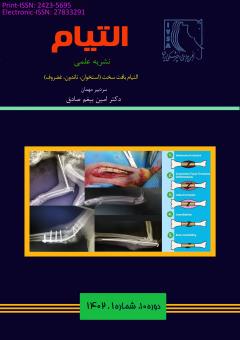مروری بر بیماری های ارتوپدی سگ ها و گربه های جوان
محورهای موضوعی : علوم جراحی دامپزشکی شامل جراحی های بافت های سخت و نرم
عارف قشقایی
1
*
,
امین بیغم صادق
2
![]()
1 - دانشجو، گروه علوم درمانگاهی، دانشکده دامپزشکی دانشگاه شیراز. شیراز، ایران
2 - استاد، گروه علوم درمانگاهی، دانشکده دامپزشکی دانشگاه شیراز. شیراز، ایران
کلید واژه: ارتوپدی, جوان, استخوان, نوزادی,
چکیده مقاله :
بیماریهای ارتوپدی حیوانات جوان، سیستم اسکلتی-عضلانی نابالغین را متأثر میکند و بیشتر این بیماریها را میتوان در روندهای پاتولوژیک (مانند بیماریها، سموم، تغذیه نامناسب، تروما) در این دوره ردیابی کرد. این بیماریها مربوط به استخوان-ها و مفاصل در طول رشد اسکلتی پس از زایمان، عمدتاً در 26 هفته اول زندگی، شروع و ایجاد میشوند. این گروه از شرایط پاتولوژیک سگ های جوان و گربه ها از جمله بیماری های ارتوپدی مادرزادی و نوزادی، شامل بیماری هایی هستند که در دوره پیش از تولد یا در 3 تا 4 هفته اول زندگی رخ می دهد. در دوره رشد، مورفولوژی مفاصل تکامل می یابد استخوان ها نیز بالغ شده و به طول و شکل خود در حیوان بالغ می رسند. بیماریهای ارتوپدی حیوانات جوان انحرافات این فرآیند های منظم هستند. این بیماریها یک مشکل شایع در سگها و گربهها هستند که میتوانند درد و عدم راحتی قابل توجهی را ایجاد کنند. این بیماریها میتوانند استخوانها، غضروف و مفاصل حیوانات جوان را تحت تأثیر قرار دهند و باعث لنگش، سفتی و مشکل در حرکت شوند. تشخیص زودرس و درمان برای کسب نتیجه موفق در این بیماریها بسیار حائز اهمیت است. کلینیسین دامپزشک باید از نشانهها و علائم این بیماریها، شامل لنگش، درد مفاصل، تورم و مشکل در حرکت، آگاه باشد. آزمایشهای تشخیصی مانند رادیوگرافی و آزمایش خون میتوانند به تأیید تشخیص کمک کنند. با توجه نوع بیماری گزینه های درمانی متفاوت است و می تواند شامل داروها، جراحی یا مداخلات دیگر بوده و حتی ممکن است غیر قابل درمان باشند. پیشگیری نیز در کاهش خطر بیماریهای ارتوپدی سگها و گربهها جوان مهم است، با جلوگیری از جفت گیری و عقیم سازی حیوانات دارای اختلالات ژنتیکی می توان از ابتلا نسل بعدی به بیماری های ژنتیکی پیشگیری کرد. تغذیه، ورزش و مدیریت وزن مناسب نیز میتواند به توسعه سالم استخوان و مفصل در حیوانات جوان کمک کند. چکاپ های دورهای دامپزشک نیز میتواند به شناسایی مشکلات بالقوه در زمان مناسب کمک کند و به مداخلات و درمان سریع منجر شود.
Orthopedic diseases of young animals affect the musculoskeletal system of juveniles, and most of these diseases can be traced to pathological processes (such as diseases, toxins, improper nutrition, trauma) during this period. These diseases related to bones and joints begin and develop during skeletal development after birth, in the first 26 weeks of life. This group of pathological conditions of young dogs and cats, including congenital and neonatal orthopedic diseases, includes diseases that occur in the prenatal period or in the first 3 to 4 weeks of life. During the growth period, the morphology of the joints develops, the bones also mature and reach their length and shape in an adult animal. Orthopedic diseases of young animals are deviations of these regular processes. These diseases are a common problem in dogs and cats, can be painful and are not easily noticeable. These diseases can affect the bones, cartilage and joints of young animals and cause lameness, stiffness and difficulty moving. Early diagnosis and treatment are very important for successful outcome in these diseases. Veterinary clinicians should be aware of the signs and symptoms of these diseases, including lameness, joint pain, swelling, and difficulty moving. Diagnostic tests such as radiography and blood tests can help make the diagnosis. According to the type of disease, the treatment options are different and can include drugs, surgery or other interventions and may even be incurable. Prevention is also important in reducing the risk of orthopedic diseases in young dogs and cats, by preventing the mating and sterilization of animals with genetic disorders, it is possible to prevent the next generation from getting genetic diseases. Nutrition, exercise and weight management can also contribute to healthy bone and body growth in young animals. Veterinary course checkups can also help identify potential problems at the right time and prompt interventions and treatment.
1. Peterson ME, Kutzler M. Small Animal Pediatrics: The First 12 Months of Life. St. Louis: WB Saunders, 2011.
2. Wisner ER, Pollard RE. Orthopedic diseases of young and growing dogs and cats. In Thrall D (ed): Textbook of Veterinary Diagnostic Radiology, 5th ed. St. Louis: Saunders, 2007, pp 268-283
3. Doige CE, Pharr JW, Withrow SJ. Chondrosarcoma arising in multiple cartilaginous exostoses in a dog. JAAHA 1978; 14:605-611
4. Schulz KS, Payne JT, Aronson E. Escherichia coli bacteremia associated with hypertrophic osteodystrophy in a dog. JAVMA1991; 199:1170-1173.
5. Towle HA, Breur GJ. Miscellaneous orthopedic conditions. In Tobias KM, Johnston SA (eds): Veterinary Surgery: Small Animal, Vol 1. St. Louis: Elsevier Saunders, 2012, pp 1112-1126
6. Breur GJ, Lambrechts NE. Osteochondrosis. In Tobias KM, Johnston SA (eds): Veterinary Surgery: Small Animal, Vol 1. St. Louis: Elsevier Saunders, 2012, pp 1178-1189
7. Fossum TW. Diseases of the joints. In Small Animal Surgery, 4th ed. St. Louis: Elsevier, 2013
8. Breur GJ, McDonough SP, Todhunter RJ. The musculoskeletal system. In Peterson ME, Kutzler MA (eds): Small Animal Pediatrics: The First 12 Months of Life. St. Louis: Elsevier Saunders, 2011, pp 443-460

